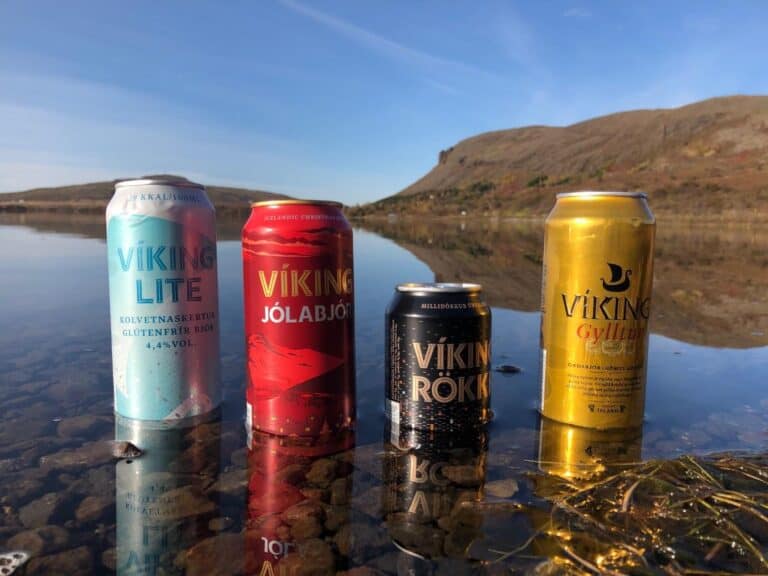
Even though Iceland is a small country, it does not have to hide behind its beer culture and art of brewing. Wine growing and pressing was never really possible here, so that the Vikings were concentrating on brewing beer. As opposed to Germany, one of the main ingredients is abundant here, the Icelandic glacier water – the purest water in the world, which gives the beer a fresh, pure and natural taste. Also no one needs to set up signs before brewing, asking people not to crap into the river during the following days, so that the water is clean enough for brewing.

The history of beer in Iceland goes back to the Northmen who have settled here the first. Today, many people who travel here are amazed about the countless Icelandic breweries and microbreweries that have arisen from such a small population and have already brewed hundreds of different and unique beers.

But beer in Iceland was actually banned for a long time. Almost an entire century. In the beginning of the 20th century, even the best beer was considered to be “out of fashion” because Iceland was trying to break away from Denmark and become independent. At that time, beer was strongly associated with the Danish lifestyle. In 1908 there was a referendum in which 60% of the population voted for a general alcohol ban as from 1915. Women did not have any right to vote that time but were simply counted as voting for it. The smuggling of alcohol had of course never stopped and various types of alcohol were allowed one after the other again, for example as medicine. So wine was rated to be “remedial” for bad nerves, and schnapps “good for the heart”. Furthermore, Spain threatened to stop buying salt fish (Iceland’s top export that time) if Iceland would not buy Spanish wine in exchange. In 1921 red and rosé wine from Spain and Portugal was therefore legalized again.
Only beer was not admitted as medicine by any of the doctors and therefore remained banned until 1989. From 1979 pilots, flight crew members and arriving tourists were allowed to import duty-free beer. Icelanders themselves were allowed from 1980 to enter the country with beer, with 6 liters of imported and 8 liters of locally brewed beer (brewed in Iceland, but not available anywhere else outside the airport). In 1988 the Icelandic parliament Althing finally voted for beer to be legalized again bringing this large business back to Iceland. According to this, beer was allowed to sell, buy and drink again from March 1st, 1989. Today 1st of March is Iceland’s National Beer Day – called “Bjórdagurinn”.

In Iceland, beer can only be sold in the state-owned alcohol and tobacco shops called Vínbúðin (ÁTVR). In 2015, a draft law was proposed to stop the state’s monopoly on alcohol sales.
The oldest beer recipes are probably more than 5000 years old. And the first professional brewers were actually women. Even with the ancient Egyptians, the workers who built pyramids were paid with beer. They drank up to 4L of the barley juice per day, because it was healthier than the filthy water of the Nile. As the saying goes about the Vikings, in earlier times they might have believed that after their death they will meet with a giant goat named Heidrun in Walhalla, from whose udder beer flows out for them.

If you’re not in the mood to hit the popular bars for a night of drinking in the city, Iceland travelers can relax at the beer spa in the north and enjoy the best icelandic beer in the beer bathtub. And the famous beer belly also does not come from the beer itself. It only arises because hops stimulate the appetite and you simply get more hungry. A 0.3L Pilsner for example has 120kcal, a white wine 0.2L has the same number of calories and a glass of red wine 0.2L has even 160kcal. Sparkling wine (0.1L) has 80kcal and 0.02L vodka has 45kcal.
Some of the most famous breweries in Iceland are Einstök Beer Co. Akureyri, which brews currently 7 types of beer, Ölvisholt Brugghús in Selfoss brews 38 different beers, Borg Brugghús in Reykjavík has a selection of 52 beers, Briggjan Brugghús brews 36 types, Gæðingur Brugghús in Reykjavík brews incredible 152 different beers, Brothers Brewery from the Westman Islands brews 23 different beers. There are of course countless more such as Egill Skallagrímsson´s Brewery, the Víking Brewery, Bruggsmiðjan Kaldi, Rvk brewing Co., Austri Brugghús, Húsavik Öl, Ölverk Hveragerði (use geothermal heat to brew their beer), Smiðjan Brugghús , Steðji Brugghús in Borgarfjörður, to mention just a few.

By the way, Brugghús is the name for a brewery / brewery house. Just like Ölgerð (literally beer makery). And beer in Iceland is called Bjór. Simply check the labels on bottles or cans to try the local Icelandic beer. Some of the breweries offer tours and tastings. Information on this can be found on the homepage of the respective brewery.
P.S.: Did you already try untappd.com?

